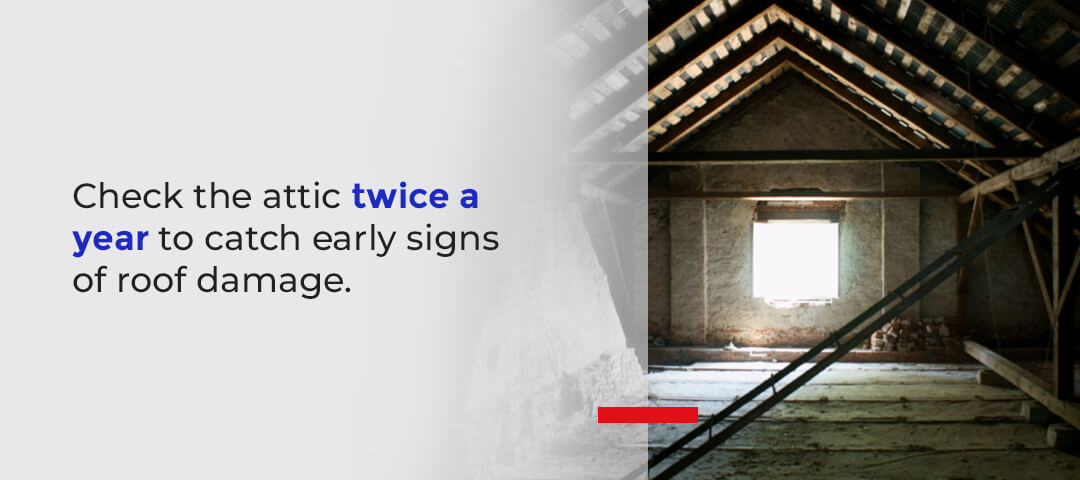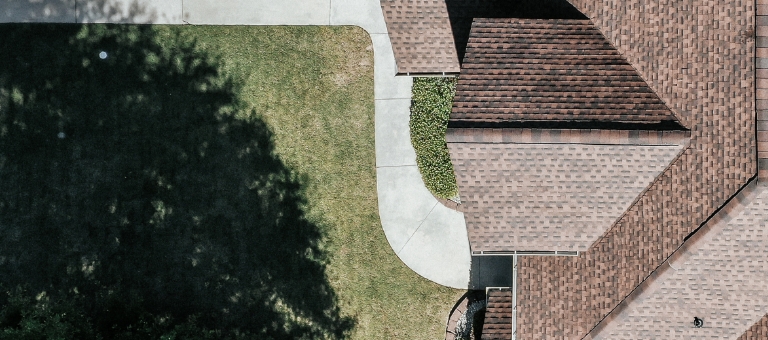
- Sagging
- Missing shingles
- Moss, mold or rot
- Dark spots or holes
- Signs of leaking or water damage
- Damaged, cracked or loose shingles
Life Spans of Different Types of Roofing Material
The most significant contributing factor of how long a roof will last is the type of roofing material used.- Asphalt shingles: Asphalt shingles have a life span of 15 to 30 years. Three-tab asphalt shingles typically last 15 to 20 years before replacement. A more resistant version, architectural asphalt shingles can last up to 10 years longer.
- Clay or cement tiles: One of the most durable roofing materials, clay or concrete shingles can last 50 to 100 years, offering your home extra protection.
- Slate roofing: Slate, the hardiest of roofing materials, can last over 100 years. Slate roofs are also one of the most expensive.
- Wood shingles: Wood shingles can last between 20 and 25 years. Proper maintenance of wood shingles can help extend the roof’s life span. Maintenance includes keeping the roof clear of leaves and other materials to avoid trapping moisture, which can encourage decay.
- Composite shingles: A durable option, composite shingles can last between 30 and 50 years.
- Metal roofs: Metal roofs typically last between 50 and 75 years. Steel roofs last about 50 years. A roof made of zinc or copper can last over 100 years.
- Rubber roofs: Rubber roofing is made of rubber or plastic polymers or a combination of both. These roofs can last 30 to 50 years with the proper maintenance.
How to Determine if You Need a New Roof
The type of roofing material plays a prominent role in how long a roof lasts, but other factors are at play. Here are some different things to check to tell if you need a new roof.1. Check the Attic to See When to Replace Your Roof
Not sure where to begin to see if it’s time to replace your roof? Start to the area closest to the roof, the attic. Check the attic twice a year to catch early signs of roof damage. Look for light coming through the roof, indicating a hole in your roof that will need patching. If you can see light through the roof, water can get in too.
Other signs to look for include stains or streaks, which indicate you have a leaky roof. Depending on the extensiveness of the leak, you may need a roof replacement.
Even if you don’t see anything, you’ll want to look for other signs to ensure your roof does not need replacing.
Check the attic twice a year to catch early signs of roof damage. Look for light coming through the roof, indicating a hole in your roof that will need patching. If you can see light through the roof, water can get in too.
Other signs to look for include stains or streaks, which indicate you have a leaky roof. Depending on the extensiveness of the leak, you may need a roof replacement.
Even if you don’t see anything, you’ll want to look for other signs to ensure your roof does not need replacing.
2. Find out How Long Ago the Roof Was Replaced
Whether you just moved into the home, have lived in the house for a while, or built it yourself, you should have paperwork stating when the roof was installed or replaced and what material makes up the roof. Knowing how old your current roof is and the type of roofing material will help you understand if you need a new roof. If it’s been over 15 years, it may be time to look into replacing your roof. If you don’t know when your roof was installed, a professional roofer can give you a good estimate.3. Check for Growth or Damage on the Shingles
This step involves little effort. When you’re outside, look at the roof. Do you see anything growing on the roof? While you may think that this adds a charming character to your home, it’s actually bad news. Moss, mold, fungi or anything else growing on your roof often means you have moisture trapped in your roof. If you have wood shingles, things growing on your roof could also indicate rot. You’ll also want to keep an out for other types of roof damage. When the seasons change or after a heavy thunderstorm or another storm, check your roof for damage. If you see cracked, damaged or buckling shingles, then you need to repair those pieces. If you see lots of shingle pieces in the gutters and downspouts, then it is probably time for a new roof. Seeing growth and damaged shingles on your roof can indicate roof problems you need to deal with before those issues grow into a costly emergency.4. Check for Roof Rot
Finding any rot or signs of decay means you need to replace your roof. Roof rot can affect the supporting structure of your roof and lead to roof collapse if you don’t address the damage promptly. Signs of rot include:- Rotting boards
- Trapped moisture
- A droopy, saggy roof
- Sagging spots at the lowest point in the roof
5. Check the Flashing
Roof flashing directs water away from areas on your roof where the shingles meet protrusions like skylights or a chimney. These flashings usually consist of aluminum, steel or copper and are an essential part of your roof. When determining how long your roof will last, look at the flashings. Check for cracks and breaks which could lead to leaks. Many older homes have flashing made up of cement or tar. If this is the case for your home, consider updating your roof to have metal flashing to increase durability and protect your roof from leakage.Call US Roofing for Your Roofing Needs
 How often should you replace your roof? There’s no definite answer to that question, but there are signs to look for when considering how long a roof lasts. If you see any of these signs or need a second opinion, we can help.
Contact US Roofing for all your roofing needs. We are available to take your calls Monday through Saturday and assure you of year-round roofing services for every need. Call us at 855-877-6631 or fill our online form for a free inspection! We serve Augusta, Georgia, and the surrounding communities.
How often should you replace your roof? There’s no definite answer to that question, but there are signs to look for when considering how long a roof lasts. If you see any of these signs or need a second opinion, we can help.
Contact US Roofing for all your roofing needs. We are available to take your calls Monday through Saturday and assure you of year-round roofing services for every need. Call us at 855-877-6631 or fill our online form for a free inspection! We serve Augusta, Georgia, and the surrounding communities.



